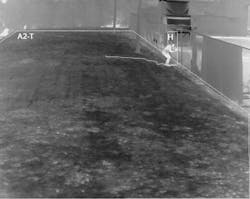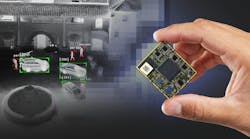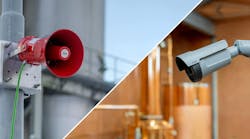This article originally appeared in the January 2022 issue of Security Business magazine. When sharing, don’t forget to mention Security Business magazine on LinkedIn and @SecBusinessMag on Twitter.
You may have noticed that “thermal imaging” has made quite a few on-screen cameos in the past few years. A character in Amazon Prime Studio’s The Tomorrow War (2021), starring Chris Pratt, used a handheld thermal imaging device to identify a technology Pratt had fixed onto his wrist. Thermal also appeared in Netflix’s hit series, Squid Game (2021), when the show’s masked guards used hidden thermal surveillance cameras to monitor the game’s contestants, after the lights had been shut off.
Thermal imaging technology, of course, is nothing new; in fact, the technology was first developed for U.S. military surveillance applications in the 1960s. Since then, the technology has made its way into law enforcement, search and rescue, industrial and commercial security applications.
According to comprehensive research by Yole Développement, the global thermal camera market saw a 76 percent growth due to the pandemic, swelling to a $7.6 billion market in 2020. A key catalyst for this growth was heightened awareness about thermal technology as a screening tool to detect elevated skin temperature during the pandemic; however, this created widespread interest in thermal technology as a whole, which led to heightened demand for other use-cases – including security and outdoor intrusion detection.
As most integrators understand, thermal cameras capture infrared energy (i.e. heat). Everything from plants to people gives off some measure of thermal energy – even in complete darkness. Because of this, thermal cameras offer customers robust detection capabilities, even in the most extreme environmental conditions, such as ice, snow, rain, fog, etc.; however, recent advances are also enabling the layering of devices, the combination of multiple sensors in one device – establishing thermal technology as a trusted tool for perimeter surveillance.
Today, thanks to increases in performance, simpler installation and decreases in price, use-cases for thermal are broadening, enabling systems integrators to better sell these solutions and create more robust strategies for perimeter security.
Increased Performance
As thermal cameras continue to see strong demand for perimeter security projects, integrators must be aware of new thermal solutions available. These cameras feature technology advancements, including improvements in thermal sensitivity, which lead to higher detection accuracy and lower total cost of ownership for end-customers.
In the field, lower thermal sensitivity enables thermal cameras to yield higher performance in bad weather conditions, creating a range of options in quality and performance.
A way to qualify midwave (MWIR) and longwave (LWIR) infrared cameras specifically is by its noise equivalent temperature difference (NETD). This metric is a measure of how well a thermal imaging detector can distinguish between very small differences in thermal radiation in a given image, i.e. how sensitive the device is. In other words, NETD it is a signal-to-noise figure which approximates the minimum temperature difference the camera can resolve. This measurement is also sometimes referred to as “Thermal Contrast,” as a more sensitive device will produce higher contrast images.
When the noise in an image is equivalent to the smallest measurable temperature difference, the detector has reached the limit of its ability to resolve a useful thermal signal, so the more noise there is, the higher the NETD value of the detector.
Integrators should be mindful of a camera’s measure of thermal sensitivity to distinguish the level of quality. Some cameras may hide poor sensitivity by measuring NETD at 50 degrees Celsius instead of the industry-standard 30 degrees. The difference in resulting images speaks for itself. It doesn’t matter how impressive a camera’s range, field of vision (FOV), resolution, or focus abilities are, if the sensor cannot detect narrow temperature differences, its detection capabilities will be inherently limited.
Simplifying Installation
In addition to improvements in thermal sensitivity, new cameras simplifying installation time and project expenses have also emerged in the market. A prime example is fixed, multispectral cameras that combine both thermal and 4K visible sensors in one housing.
These options are becoming popular, as they amalgamate multiple technologies into one device, thereby minimizing infrastructure costs and installation processes. These devices also close the gap between detection and threat assessment functionalities performing both tasks at the same time, streamlining incident response and saving security personnel critical seconds.
Creating Perimeter Security Redundancy
Integrators are also making use of proven perimeter intrusion detection system (PIDS) design strategies to create redundancy and further improve threat assessment. Layering thermal sensors, for example, with other emerging technologies, such as ground-based radar systems, enables security personnel to maximize the benefits of both technologies.
Radar, for instance, can detect incoming ground and aerial threats from impressive distances, far beyond a facility’s perimeter, and display this data using geo-location-based mapping technology, delivering first responders accurate, real-time insights. When paired with thermal sensors embedded in pan-tilt-zoom (PTZ) cameras, these systems can also use this data to cue a PTZ device to slew to the target, verify whether it is an intruder, and proceed to track them as they move.
The combination of both insights reduces the likelihood of a false alarm and ensures a detected threat will never evade visibility.
Kai Moncino is Director of Global Business Development - Security for Teledyne FLIR. Request more info about the company at www.securityinfowatch.com/10213696.



